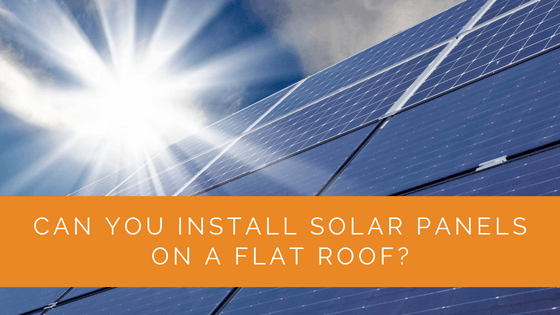Green energy is the future, and solar panels are a great way to start. When people think about solar panels, they consider putting them on sloped roofs.
What if your roof is flat, though? Can you install solar panels on a flat roof?
Yes, you can! It’s not uncommon for people to install solar panels on a flat roof. However, remember that there are different factors to consider when installing solar panels on a flat roof, such as the type of roofing and nearby buildings.
This post explores why someone would want to install solar panels on a flat roof and the factors that influence installing solar panels on flat roofs.
Contents
- 1 Key Takeaways
- 2 Benefits of Installing Solar Panels on a Flat Roof
- 3 Factors to Consider in Installing Solar Panels on a Flat Roof
- 4 Cost Considerations for Installing Solar Panels on a Flat Roof
- 5 Safety of Installing Solar Panels on a Flat Roof
- 6 Efficiency of Solar Panels on a Flat Roof
- 7 Challenges of Installing Solar Panels on a Flat Roof
- 8 Case Study: Successful Installation of Solar Panels on a Flat Roof
- 9 Expert Insights From Our Solar Panel Installers About Installing Solar Panels on a Flat Roof
- 10 Experience Solar Excellence with Us!
- 11 Wrapping Up
Key Takeaways
- Solar panels can be installed on flat roofs, offering easier installation, maintenance, and space utilization than sloped roofs.
- Factors to consider when installing solar panels on a flat roof include the roof material, panel support methods, and nearby buildings that may cast shadows on the panels.
- Contrary to a common misconception, installing solar panels on a flat roof is not necessarily more expensive than on a sloped roof. It can even be more cost-effective due to simpler labor requirements. However, the roof must be structurally sound to support the panels.
Benefits of Installing Solar Panels on a Flat Roof
Many people think installing solar panels on a flat roof isn’t worth the hassle because there’s no way for the sun to hit them. Well, this is false!
The truth is that it’s possible to direct solar panels on a flat roof toward sunlight. It’s worth noting that installing solar panels on a flat roof is less complicated than installing them on a sloped roof. They’re also easier to maintain.
Installing solar panels on a flat roof is easy since you can easily move around the deck. This is unlike sloped ones, where you’ll need to balance yourself right and need a helper on the ground to deliver the solar panels to you on the roof.
Solar panels on a flat roof are easy to maintain once installed. Just go up and check the panels at your leisure without needing a harness. With a sloped roof, though, things are a little more complicated.
Also, you’ll be able to maximize the space of your roof. With a sloped roof, you can only install solar panels on parts that aren’t too difficult to mount. With a flat roof, every free space will most likely be suitable for a panel installation.
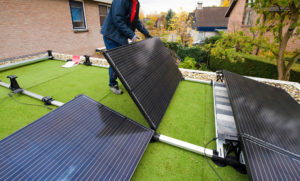
Factors to Consider in Installing Solar Panels on a Flat Roof
If you have a flat roof, you probably wonder if solar panels are the right choice for your home. They can be an excellent way to obtain energy from the sun, but there are a few things to consider before installing them.
Roof Material
First, you should know what material your flat roof is made of.
Nowadays, many homeowners go for Single Layer Membrane Roof when it comes to flat roofing since they’re perfect for installing things like water tanks or solar panels.
Hopefully, your roof isn’t made of shingles since they tend to collect water on flat roofs.
Installing solar panels on top of shingles could cause water damage in the future, so you’ll need to change the material to accommodate your solar panels.
Panel Support
Flat-roof solar panels are often mounted onto a tub that’s weighed down by ballast to resist strong winds. The ballast can be anything from gravel and paving slabs to rocks and bricks.
Alternatively, you can mount the solar panels onto metal frames based on your location and building structure.
Nearby Buildings
Last, consider the nearby buildings. Since you have a flat roof, some buildings may overshadow your whole roof, blocking the sunlight.
This means your solar panels won’t be exposed to as much sunlight as you’d like, which translates to lower energy.
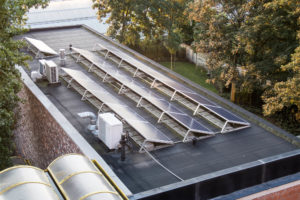
Cost Considerations for Installing Solar Panels on a Flat Roof
You might have heard that installing solar panels on a flat roof can be more costly than putting them on a sloped roof, but is that true?
It’s a common misconception that installing solar panels on a flat roof is more expensive than installing them on a sloped roof. The cost may vary depending on your needs, but it won’t be more expensive than a sloped roof installation.
A flat-roof installation may cost you less than a sloped-roof one. This is because labor can be cheaper with a flat-roof installation, as there won’t be any steep-roof climbing. The laborers will move freely on your flat roof without needing special equipment.
You might not even need laborers if you’re the DIY type. There are plenty of tutorials online on how to install solar panels on a flat roof all by yourself or with the help of a friend.
On the other hand, installing solar panels on a sloped roof alone can be dangerous because you won’t be able to move freely, and you’ll have to watch every step you take.
Safety of Installing Solar Panels on a Flat Roof
It’s safe to install solar panels on a flat roof, but there are some caveats to consider
The first thing you need to know is that your roof must be able to support the weight of the solar panels. This may be an issue if you have an older home.
You can calculate how much weight your roof supports by calling your local building code office and asking for the information. You may also use an online calculator.
You’ll also want to ensure the roof is in optimal condition before installing solar panels. If it has cracks or peels, it might not be able to withstand heavy loads.
So, consider fixing your roof before installing solar panels if it’s old or damaged.
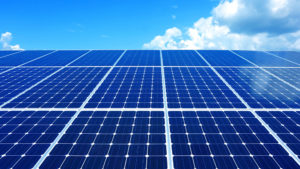
Efficiency of Solar Panels on a Flat Roof
Solar panels work best when exposed to as much sunlight as possible. That’s why roofs with a lot of sun exposure tend to be the best location for installing solar panels.
So, what about flat roofs?
There’s no right and wrong answer here: solar panels installed on a sloped roof will work as efficiently as on a flat roof with the same amount of sunlight.
Your roof’s pitch affects how much sun hits it and how much light is reflected off it. A steeper pitch will reflect more light than a shallow one, but it also means that less sunlight will hit your roof and be converted into usable energy.
Challenges of Installing Solar Panels on a Flat Roof
A solar panel installation on a flat roof is possible but has some challenges. It’s important to fully understand these challenges before deciding whether or not installing solar panels on your flat roof is the best option for you.
Fixing the Panels to a Flat Roof
As we stated earlier, solar panels must be supported to withstand heavy winds. Luckily, they’re easier to support on a flat roof than on a sloped one since workers can move more freely.
Design and Framework of Panels on a Flat Roof
Solar panels must be designed and installed with a flat roof in mind. They need to be placed in a way that allows them to absorb as much sunlight as possible while also providing enough space between them so that they get plenty of ventilation.
A flat roof is the most logical location to install solar panels because it’s a large open space that can accommodate many panels.
Weight of Solar Panels on a Flat Roof
The weight of solar panels is a major consideration. Solar panels can be heavy, especially when installed in a large array. If you plan on installing more than one set of solar panels, ensure your flat roof has enough support for them.
A common rule of thumb is that your roof should be able to support 40 pounds per square foot, which includes the mount already.
However, the overall weight support of your roof also depends on the building design, so you’ll probably need to seek professional help before starting the installation process.
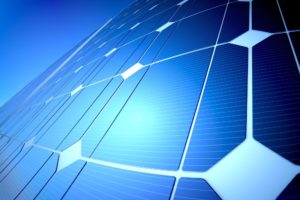
Draining the Solar Panels on a Flat Roof
One of the unavoidable challenges of installing solar panels on a flat roof is drainage. Solar panels need to be level, and they also need to drain water away from your building, which is why it’s tricky to install them on a flat roof.
When installing solar panels on a sloped roof, you can use the slope’s angle as part of your drainage plan by directing rainwater downhill with gutters or downspouts.
On a flat roof, water will collect around your solar panels and cause them to rust, causing damage to the roof and the building itself.
Moreover, flat roofs are more vulnerable than sloped ones because they’re exposed to more elements (like hail). They often don’t last as long as other roofs, and they need repairs or replacement sooner rather than later, which can greatly affect your solar panels.
Case Study: Successful Installation of Solar Panels on a Flat Roof
Background
At Solar Panels Network USA, we pride ourselves on providing tailored solar solutions for various roof types. One of our recent projects involved installing a solar panel system on a flat roof for a residential client. This case study explores the challenges and solutions associated with flat roof installations.
Project Overview
A homeowner with a flat roof contacted us to install a solar panel system. They wanted to take advantage of the ample space on their roof and the ease of maintenance that flat roofs offer. Our task was to design and install a solar system that maximized energy production while ensuring proper support and drainage.
Implementation
Assessing the Roof:
We began by evaluating the roof’s condition and material. The roof was made of a single-layer membrane, ideal for supporting solar panels due to its durability and ease of installation. We checked for any existing damage and assessed the roof’s structural integrity to ensure it could support the weight of the solar panels.
Designing the System:
We designed a system using a ballasted racking system, which is weighted down with ballast like gravel and paving slabs. This method avoids roof penetrations, reducing the risk of leaks and making the installation process simpler and quicker.
Panel Placement and Orientation:
To optimize sunlight exposure, we oriented the panels at an angle using adjustable mounts. This ensured the panels would capture maximum sunlight throughout the day. We also considered nearby buildings to avoid shading issues that could reduce the system’s efficiency.
Ensuring Proper Drainage:
Flat roofs can pose drainage challenges. We ensured that the panels were installed at a slight tilt to facilitate water runoff. This prevents water accumulation around the panels, reducing the risk of rust and damage to the roof and the panels.
Installation Process:
- Preparation: Cleared the roof of any debris and inspected for any potential issues that needed addressing before installation.
- Mounting: Installed the ballasted racking system, carefully placing the ballast to ensure stability and prevent movement.
- Panel Installation: Mounted the solar panels on the racking system, ensuring secure attachments and proper alignment.
- Electrical Work: Connected the panels to the inverter and the home’s electrical system, ensuring all connections were safe and compliant with local codes.
- Final Inspection: Conducted a thorough inspection to ensure everything was installed correctly and the system was operational.
Results
The installation was completed successfully, and the homeowner was delighted with the outcome. The system generated sufficient energy to meet their needs, and the flat roof installation provided easy access for maintenance. The client also noted a significant reduction in their energy bills and was pleased with the system’s overall performance.
Summary
Installing solar panels on a flat roof offers numerous advantages, including ease of installation and maintenance. At Solar Panels Network USA, we ensure that every installation is tailored to the specific roof type and client needs. This case study highlights the importance of proper roof assessment, system design, and installation techniques to maximize energy production and ensure the system’s longevity.
By leveraging the benefits of flat roof installations, clients can enjoy efficient and cost-effective solar energy solutions.
Expert Insights From Our Solar Panel Installers About Installing Solar Panels on a Flat Roof
Flat roofs offer easier installation and maintenance compared to sloped roofs. You can walk freely on the roof, making the process more efficient and less labor-intensive.
Senior Solar Technician
Ensuring proper panel support and drainage is crucial. Using ballast systems and strategic panel placement can optimize sunlight exposure and prevent water accumulation.
Lead Solar Installer
Flat roof installations can be more cost-effective due to simpler labor requirements. However, it’s essential to ensure the roof’s structural integrity to support the weight of the panels.
Certified Solar Engineer
Experience Solar Excellence with Us!
Trust in Solar Panels Network USA, where our seasoned experts deliver top-quality solar solutions for homes and businesses nationwide. With a legacy of countless successful installations and a commitment to sustainable energy, we’re your reliable partner in the solar journey. Ready for a brighter, eco-friendly future? Call us now at (855) 427-0058 and harness the sun’s power!
Wrapping Up
Installing solar panels on a flat roof is possible but has many challenges, such as drainage, panel support, and nearby buildings. These challenges can be avoided or mitigated with professional advice and proper maintenance.
To install solar panels on your flat roof, you must ensure the panels are mounted correctly and securely. You’ll also want to ensure that there are no leaks in the roof that could damage your system.
Don’t forget to consider the nearby buildings that might overshadow your roof; your solar panels must be getting as much sunlight as possible to provide you with enough energy to justify their cost.
The most important thing to remember here is that solar panels can be a great investment for your home; regardless of whether they’re on a flat roof or not, solar panels will reduce your energy bills, help the environment, give you control over your electricity, and increase the value of your home. What’s not to like?
About the Author
Solar Panels Network USA stands at the forefront of solar energy solutions, driven by a team of seasoned solar engineers and energy consultants. With over decades of experience in delivering high-quality solar installations and maintenance, we are committed to promoting sustainable energy through customer-centric, tailored solutions. Our articles reflect this commitment, crafted collaboratively by experts to provide accurate, up-to-date insights into solar technology, ensuring our readers are well-informed and empowered in their solar energy decisions.

